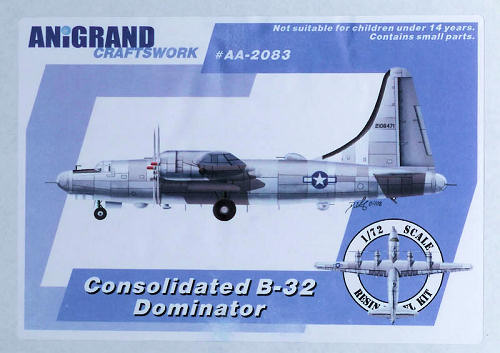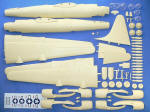
Anigrand 1/72 Consolidated B-32 Dominator
| KIT #: | AA-2083 |
| PRICE: | $136.00 SRP |
| DECALS: | One option |
| REVIEWER: | Andy Abshier |
| NOTES: | Resin short run kit with resin clear bits |

| HISTORY |
The B-32 is one of those aircraft that rates little more than a footnote in the
history of the U.S.
Army Air Force (USAAF). Its service life was less than one year, and the type
saw little action in the war it was built to fight, though it did have the
distinction of participating in the last air battle of World War II.
In January 1940 the USAAF issued a set of formal requirements for a "superbomber"
to replace the B-17s and B-24s in service. The new bomber was to be superior
to the existing designs in speed, armament, and payload. Four
manufacturers--Boeing, Consolidated, Douglas, and Lockheed--submitted designs
for the new superbomber. Of the four designs the USAAF favored the Boeing B-29,
but ordered prototypes of Consolidated's design, designated the B-32, as
insurance in case the B-29 program failed.
Like the Boeing B-29, the B-32 was to have been a pressurized-fuselage bomber
with remotely controlled turrets. Consolidated, however, ran into considerable
problems with both the cabin pressurization and gun turrets, to the point where
the prototype, already six months behind schedule, eventually flew as an
unarmed, unpressurized aircraft for the first time on September 7, 1942.
Development problems continued, and the second prototype did not fly until May
10, 1943. By the end of 1943, the USAAF had ordered so many changes to the
prototypes that the fuselages were nearly totally redesigned. Pressurization
and remotely-controlled turrets were dropped, and five manned turrets were
installed. After initially flying with twin B-24-type vertical fins, the design
was changed to a single fin, similar to the type being installed on the Navy's
PB4Y-2 aircraft.
By December 1944 only five production-standard aircraft had been delivered.
Cancellation of the program was recommended, but service testing continued using
both production standard B-32s and unarmed TB-32 aircraft. Numerous
deficiencies were reported, including a poorly laid out flight deck, poor
bombardier visibility, landing gear failures, and cooling problems with the
engines. On the other hand, the aircraft handled well, was a stable bombing
platform, and was was relatively easy to maintain.
The B-32 program might have ended there but for Lt. Gen. George C. Kenney,
commander of the Far East Air Forces. He had wanted to replace B-24s with
B-29s, but B-29 production was entirely committed to 20th Air Force. Gen.
Kenney then requested the B-32.
A detachment of three B-32s were dispatched to the Philippines for combat
testing. The first combat mission was flown by two B-32s on May 29, 1945. Over
the next two months the B-32s flew missions over the Philippines, Formosa, and
the Gulf of Tonkin. The type was deemed acceptable for combat, and the 386th BG
began converting to the B-32.
Before the conversion was complete, the atomic bombs were dropped on Japan.
Combat operations by the 386th BG
began in August. Their missions over Japan were photo-reconnaissance missions
to determine Japan's compliance with the August 15 cease-fire. The aircraft
retained full defensive armament, and the B-32s were attacked on August 17 and
18 by fighters of the Kido Butai; one of the attacking pilots was Saburo Sakai.
The August 18 attack was the last air battle of World War II.
The last mission flown by the B-32 was August 28th, but two aircraft were lost.
One crashed on takeoff, killing all 13 aboard, and the other lost power in two
of four engines. Two men were killed in the bail out. Two days later, the
386th stood down, and all flyable B-32s were ordered back to the United States.
In September 1945 the B-32 program was cancelled. All aircraft that could be
flown to storage were moved, and incomplete airframes were scrapped. No B-32s
exist today--one example had been earmarked for the Air Force Museum, and was
preserved when all other B-32s were scrapped in 1947, but in 1949 it was
declared surplus and it, too, was scrapped.
Editor's note. There is a wing from one in south San Diego as a memorial. It has been rather badly vandalized with many, many dents and some bullet holes in it, but it was still pretty much intact when I last saw it in 1992.
| THE KIT |
 The
model is presented in a sturdy cardboard box with the fuselage halves loose, but
all other parts bagged in separate chambers--one for the tailpanes, one for the
wings, one for the nacelles, and one for the small parts. The clear parts, cast
in resin, are packaged in a small bag.
The
model is presented in a sturdy cardboard box with the fuselage halves loose, but
all other parts bagged in separate chambers--one for the tailpanes, one for the
wings, one for the nacelles, and one for the small parts. The clear parts, cast
in resin, are packaged in a small bag.
Casting quality is generally good. There were some air bubble faults on my
sample, mostly in places easy to fix. One big fault on my sample is the left
fuselage, which is about 2mm shorter than the right fuselage--it is possible
that on my model it was pulled from the mold before being fully cured, and
shrunk. Fortunately the constant-diameter fuselage should be easy to fix to get
the lengths right. Wings are sharply cast with no warps, but trailing edges are
a bit thick.
Interior detail is minimal, comprising seats, control yokes, and an instrument
panel for the flight deck. No detail is provided for the bombardier's area, and
turret detail is limited to guns only.
As per usual Anigrand practice, the flight deck floor and wheel wells are cast
into each fuselage half, which will leave seams to fix.
Landing gear is good, and very sturdy. Thankfully the struts are all trunion-mounted,
which is a good thing since a lot of nose weight will be needed for this model.
Wheels seem rather wide but the hubs are well cast.
Engine fronts appear to be copies of the inaccurate C-97/KC-97 engine fronts
from the Academy kits! On the plus side, the Curtiss Electric propellers are
done well. Blades are separate from the hubs, but the hubs have mounting holes
for the blades. Replace the inaccurate engines and you should be all set.
Clear parts look good, but would benefit from a dip in Future.
Aside from the fuselage fault, dry fitting of major parts showed no real
problems. The six-word rule of building limited-run kits still applies,
however: trial fit, adjust, trial fit again!
DECALS
A small sheet is provided with insignia and two serial numbers incorrect for the
B-32. Two errata decals are included with correct serials for one example,
2108471.
| CONCLUSIONS |
Anigrand continues to improve, and this kit is clearly better than the last kit I saw from this company. I would not recommend this kit to a novice all-resin kit builder, but someone with a few all-resin kits under their belt should do fine. With some extra work, you'll have a model to be proud of once you're done. It is certainly the cure for the common Messerschmitt!
| REFERENCES |
Consolidated B-32 Dominator:
http://home.att.net/~jbaugher2/b32.html
National Museum of the US Air Force Fact Sheet:
http://www.nationalmuseum.af.mil/factsheets/factsheet.asp?id=2535
Saburo Sakai's Last Battle:
http://www.j-aircraft.com/research/stories/b32.html
June 2009
If you would like your product reviewed fairly and quickly, please contact me or see other details in the Note to Contributors.